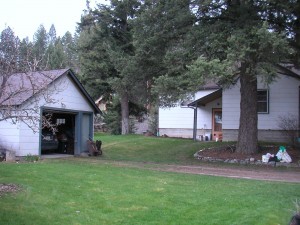by Catherine Haug, April 27, 2013
(Photo, right, of original structure on Cat’s property)
Deconstruction to reuse or repurpose building materials has long been an interest of mine. My childhood home – the same home in which I am currently living – was built, in part, from reused materials.
When Dad bought this property, it had two small structures: a habitable 3-room cabin, and a 1-room shack. We moved into the habitable one when I was not quite a year old.
Dad reused materials from the shack, including shiplap, rafters, windows, and door, for the new home he built at the site. After we moved into the new home, he reused most of the materials form the cabin to build the new garage.While Mom often teased him for being a miser, he never even thought about wasting anything he could reuse. (2011 Photo of Cat’s home, left, built 1950)
Now throughout the valley, builders are tearing down old structures and burning the materials or sending them to the landfill, so they can use all new materials for the condos or mansions they intend to build. These builders don’t seem to be aware that deconstruction is once again coming of age. They tout the LEED ratings of their new buildings without realizing that deconstruction could give them a leg up in LEED certification.
According to an article reprinted in today’s Daily InterLake: Recycling homes, even the floors, gives materials second life, by Kathleen Lynn:
“demolishing a typical house costs $15,000 – $20,000, while deconstructing the same house takes more time, and might run $25.000 to $30,000. But the materials [can be reused or] donated [such as to the Habitat for Humanity Re-Store] for a charitable deduction.”
Reasons to deconstruct
While it may cost more in labor to deconstruct that to demolish, there are many advantages to deconstruction. The following is from Deconstruction: Giving Old Buildings New Lives
- “savings on disposal costs;
- reducing demolition costs;
- decreasing disturbance to job sites;
- gaining revenues from the sale of recovered materials;
- decreasing airborne asbestos, lead, and nuisance dust at the job site;
- enhancing builders’ images of environmental responsibility;
- conserving landfill space;
- reducing air pollution from burning buildings;
- saving energy and raw materials.”
Deconstruction materials
Some older homes have beautiful oak or maple flooring, or fine kitchen cupboards that just can’t be matched in new materials. This last week I learned that one of the old bowling lanes from Bigfork’s old bowling alley has been repurposed as the coffee bar at the new Forge coffee house and cafe in the historic Boyd’s Blacksmith Shop on Kalispell’s west side.
Here’s a list of deconstruction materials that can find new life (from Deconstruction: Giving Old Buildings New Lives):
“Asphalt, Brick, Drywall, plaster, earth/soil, electrical fixers, glass, masonry and rubble, metal, plastics, roof materials, vinyl, and wood.”
Local expert
We have a deconstruction expert living right here in Bigfork, Pete Hendricks. He was featured in Old Buildings Don’t Have to Go to Waste, a 1996 video from NC Cooperative Extension, and also in a book: Unbuilding, by Bob Guy, Brad Falk (Taunton Press). We’d like to show the ’96 video at a future gathering, with Pete present to answer questions.
For more information
To learn more about deconstruction, or for inspiration, check out:
- ReuseNetwork.org
- Building Members Reuse Association at bmra.org
- TheReusePeople.org
- Wikipedia: Deconstruction (building)
- EPA: Deconstruction – Building Disassembly and Material Salvage
- Deconstruction: Giving Old Buildings New Lives (pdf from NC Cooperative Extension)
- Unbuilding, by Bob Guy, Brad Falk (Taunton Press)

